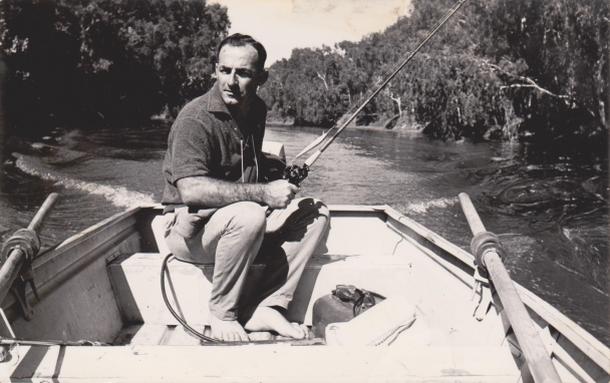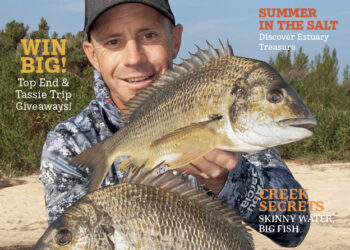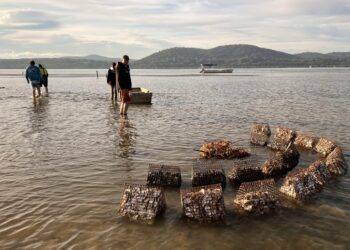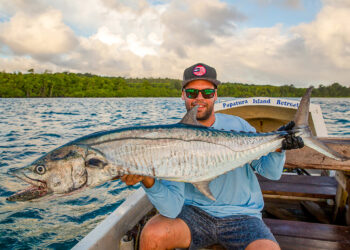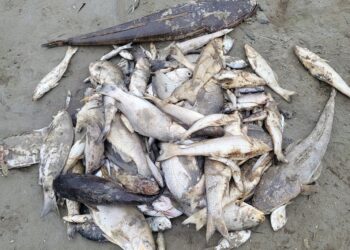LAST week Australia lost one of its most influential fishing and outdoor writers with the passing of Vic McCristal at age 86.
Vic was a legendary fishing writer who through his magazine articles, columns, and books popularised modern sportfishing and conservation in this country.
Vic’s skill as a fishing journalist remains unrivalled. “McSea”, as he was nicknamed by late Fisho founder Ron Calcutt wrote the popular column Slack Lines and was a prolific feature writer in Australian fishing and outdoor publications since the 1950s.
The thoughts of all at Fishing World go out to Vic’s family and friends. (Tributes to Vic McCristal follow).
Vic McCristal, AM
If you were never one to read outdoor magazines in the ’60s, ’70s and ’80s, then maybe you can be forgiven for not knowing about Vic McCristal. But rest assured, there will be many tough old blokes around the country who will mourn deeply the passing of a man they knew as McSea. Vic inspired many Australians to go outdoors, and did a great deal to encourage those who did to tread lightly.
Vic, who died at the age of 86 this past week in his home town of Cardwell, north Queensland was never a celebrity in the modern sense, but those who know of his work commonly refer to him as Australia’s best and most influential fishing writer. He is sometimes described as both the father of outdoor journalism and of sports fishing itself in this country.
Vic was born to a family descended from pioneer cedar getters in the Garden of Eden-like setting of Bellingen on the north coast of NSW. One of his earliest memories was the sight of fish swimming free in the Bellinger River. He later recalled, in his typical understated style, that from then on, fishing for him was never entirely about killing fish.
Before he was old enough to go to school, Vic recalled being taught how to catch prawns and ghost crabs with his bare hands by an Aboriginal woman, one of the Kelly’s from Nambucca. The trick, by the way, is to frighten prawns with one hand and catch them with the other, and for crabs, to place a small stick in the hole and ambush them when they emerge. His admiration for the bushcraft of Aborigines never left him and informed his philosophy on fishing.
He also recalled, as a 12-year-old, being scolded by an uncle for returning fish he had caught to the river. Vic later became one of the very first fishing writers to advocate catch and release – now universally practiced by anglers across Australia.
Vic got a taste of journalism on Bellingen’s Courier Sun newspaper as a young teenager, relinquishing the position when the regular journalists returned from WWII. As a young man, he worked in a range of jobs, including as a carpenter for building projects that were part of the Snowy Mountains Scheme.
In his spare time, Vic enjoyed fishing and hunting, before deciding that he could do better than many of the writers he was reading, and submitted his first article to Outdoors magazine in 1954. Vic’s exceptional clear writing style (“A lure is a lie told by a man to a fish”) and eye for detail was noticed immediately, and Vic quickly established himself as a professional writer.
Vic moved to Cardwell in north Queensland in 1966. From here he became a prominent chronicler of the glamorous early years when marlin the size of small cars were being hauled in off Cairns. Typical of him, he upset some of the local operators by challenging the tradition that the first marlin captured by an angler should be killed and brought back to shore.
This was the kind of moral stand that punctuated his career – for example, he refused to write for hunting magazines when editors started changing his copy to make a kill sound cleaner than it really was.
He is also remembered as the first person to systematically chronicle fishing for barramundi in the Kakadu and Kimberleys with lures, creating trails followed by many.
Although he wrote several books, his lasting legacy is his 1974 classic, The Rivers & The Sea. If you think it is hyperbolic to describe this as what would happen if Hemingway wrote The Canterbury Tales maybe you should find a copy. This long out-of-print book is a forgotten classic of Australian literature, and signals the time when outdoor enthusiasts began to understand they needed to look after the outdoors if they were to enjoy it.
This one work testifies to Vic’s outstanding talent, and his abiding love for the environment and those who inhabit it.
He was the Foundation President of the peak recreational fishing body, the Australian National Sportfishing Association, which had its seeds in roadside meetings with barefoot anglers. To this day, its Constitution – containing a balance of common-sense and an innate sense of fairness – has his thumbprints all over it.
Vic lived alone in Cardwell, until Cyclone Yasi precipitated a move to a local retirement home.
Vic is survived by sisters Valmai Atkins, Elaine Murphy and Moyna Whyte and his many nephews and nieces.
Gavin Atkins
(Vic’s nephew)

Vale Vic McCristal
Vic spent his boyhood in the cedar woodlands of the Macleay River Valley. In an era when computers were unimaginable, kids wore hand-me-downs and made their own fun.
And lures.
The gun design was a comma shaped bobber the timber-getters – then the mainstream industry in those hills to the west of Kempsey, that and dairy farming in cleared lands – hand carved from offcuts. Neither designed nor intended for the retrieve paths we use today, the lure was simply cast out – by hand in most cases – and doodled more or less in the one spot.
There were enough bass in the Macleay for the rest to happen.
Not surprisingly, Vic continued to work with wood and took up a position with the NSW Housing Commission in the Darling River town of Bourke. Significantly, Eric Moller – the famed luremaker and close mate in later life – was a forester.
As a maintenance carpenter, Vic fixed runny taps and replaced broken windows but switched callings for that of a meat inspector at the Tancred works where a trained goat led sheep to the slaughter.
His writing career began in earnest with the KG Murray publishing group which had Outdoors and Fishing amongst its magazine stable. It was a common enough fixture in bush barber shops, then a place where men could get much more than a shave and short back and sides – fishing tackle, guns, ammo and a bet on the horses.
The Murray Group published Freshwater Fighting Fish – a book about barra, bass and the natives that is relevant today as when it was released in the early sixties. The barra adventures, those in the book and them to follow were about setting sail into the unknown, the sunset and bulldust ahead in an FJ Holden Ute. An almost incomprehensible venture compared with today’s yellow brick road. A track I couldn’t imagine today’s softies taking on.
Vic moved to Cardwell where he lived out the rest of his 86 years. Cyclone Yasi was a last straw, flattening the town and forcing Vic into palliative care from which he never emerged.
The McCristal legacy includes the inspiration for a couple of writer generations. Sewing the catch and release seeds and establishing the sportfishing movement.
His prose was Hemingwayesq, where one smelt the mud and mangroves and felt the kicking strike of a barramundi. Latter day writings took on a green flavour and philosophical tenor – a complete about face from days of writing about shooting wedge-tail eagles on the wing with a .222. To put that in context, bush kids did things until learning better.
On song, Vic’s writing raised the bar – where it remains today.
A private, almost introverted man, McSea – a nickname conjured by Fisho founder Ron Calcutt lived the sea dog and outdoorsman life to the full up until his sixties. Then inexplicably and still near the top of his game hung up his typewriter to become a recluse. He could have become fishing’s elder statesman – the grand master – but chose quiet retirement instead.
Rod Harrison

The passing of Vic McCristal
The Australian National Sportfishing Association (ANSA) last week lost one of their most valued recreational fishers and friend, Vic McCristal. Not only was Vic a legendary fishing writer who through his magazine articles, columns, and books popularized modern sportfishing and conservation in this country, but he was also one of the founders of Australian National Sportfishing Association.
Below is a very brief history of how ANSA was formed. This talk was given by Vic at a Queensland State wide meeting held in Cairns, (1988).
The History of ANSA by Vic McCristal (circa 1988)
ANSA originated as result of fishing developments following the war, an increasing number of anglers started using modern tackle mainly bait casting rods and reels imported from the U.S., for bass, barramundi and for surfcasting. Developments are reflected clearly in magazines of the period. (Outdoors was first published in 1948, Anglers Digest in 1950).
There was an increasing recognition that the sporting value of many Australian species was not reflected in existing organisations.
From 1960 forward, a number of people had thought of the idea of a new Sportfishing organisation. I do not know who was “first” to think of it but I do know that it was discussed for quite a few years by Sydney anglers and people such as myself – a country boy. I can put a finger on one such discussion, held on the roadside just south of Kiama, between myself, Jack Erskine and Ed Pratt. That was January 1964 during my first round Australia trip. I had started my exploration of Australian fishing on July 1 1963. The next couple of years, after repeated visits, I had realised that North Queensland offered the most potential for a fishing future. Others such as George Bransford had decided the same way.
I built my home in Cardwell in 1966, with the bricklaying being done by my friend Ed Pratt, who had moved north to Cairns about the same time. The ANSA concept was understood by a number of Cairns anglers, and I believe its success came because it reflected what was happening to Australian fishing. It could not have succeeded otherwise.
In February 1967 we formed the “Australian National Sportfishing Association” at a meeting in the old hall at Yorkey’s Knob, just north of Cairns. Within a few months a constitution had been drawn up and an account opened in the Cairns branch of the Bank of NSW in the name of the “Australian National Sportfishing Association” It is worth a mention that the late Wal Hardy was patron of that initial organisation.
Dick Lewers recorded that the NSW group “got the message” of the Cairns movement and responded by forming what was then the NSW division of ANSA on Saturday August 12 1967. Three months later, in November 1967, Jack Erskine and Clyde Kelton with three NSW sport fishermen from Wollongong, John Kettle, Peter Fuller, and Bill Ferguson visited North Queensland in a light plane.
Discussions took place with the Cairns group and the accepted name of ANSA was endorsed by both groups. However, it had already become clear that the NSW fraternity would not accept the Cairns constitution. Then, as now, State Divisions (branches) were more representative of regional interests. Accordingly, the Cairns ANSA group met on February 7 1968 and became instead the Cairns Sportfishing Club.
At this time there was no Queensland Division as such, however Dick Lewers and the National Organisation have always recognised that the Cairns Sportfishing Club has the unique distinction of being the first ANSA club.
The first NSW ANSA club was the St. George Sportfishing club, which had its first general meeting on November 13 1968. On December 13 1969 the first official body was formed as the “Australian National Sportfishing Association”. The original A.N.S.A. badge design was selected from a competition published in “AUSTRALIAN SPORTFISHING”, Summer edition 1969. The winning design was submitted by John Renolds, Liverpool, NSW.
It was agreed to form the first record chart from the then existing Queensland and N.S.W. record charts. ANSA’s first official Queensland division was formed on August 5 1970 with only three clubs – Cairns, Maryborough, and Cardwell, with a State total of 150 members.
So far as ANSA goes the story since has been one of steady growth. We now have more than 200 clubs Nationwide. We are represented on every State fishing council, at Federal level, and on IGFA. Looking back we can see that the hassles over constitutions and rules, even point scores, were part of the process of developing sportfishing on a truly representative and wholly Australian basis.
One of the nicest thoughts is that many of those people who contributed to the forming of the association are still with us today.
Vic McCristal
Since the inception of ANSA and presently, ANSA continues to be at the forefront of sportfishing thanks to the efforts of our forefathers and those tireless volunteers that dedicate hours of their time to ensure that what start in 1967 lives on following the ANSA motto of “Sport, Conservation and Integrity.”
ANSA National introduced a “Vic McCristal Award” some time ago. The Vic McCristal Award is presented to an individual or organisation for outstanding contribution to the enhancement of recreational fishing in Australia.
At a NSW level we are very proud to have one of the recipients of the “Vic McCristal Award” heading the ANSA NSW Branch and the Recreational Fishing Alliance of NSW, Stan Konstantaras. Stan was presented with the Award in 2006 for his “Outstanding Contribution to the Enhancement of Recreational Fishing in Australia”.
Through awards like this and the contributions given by many tireless volunteers to sportfishing in Australia, be it under the ANSA banner or other recreational fishing associations, such as the Recreational Fishing Alliance of NSW, Vic McCristal’s legacy will continue to live on.
Thank you Vic and rest in peace.
Joe Garufi – ANSA NSW Secretary / ANSA National Membership Director
SCATTERING OF VIC McCRISTAL’S ASHES
DATE: Friday 30th January
WHERE: Missionary Bay
TIME: 10am in the Bay
VIC McCRISTAL’S WAKE
DATE: Saturday 31st January
TIME: 12 noon – lunch provided
WHERE: Cardwell Sportfishing Club (licensed premises) St Albans St, Cardwell, Q 4849
If you will be attending either the scattering of ashes or the wake for Vic McCristal, please email sawara@bigpond.com for catering purposes.





